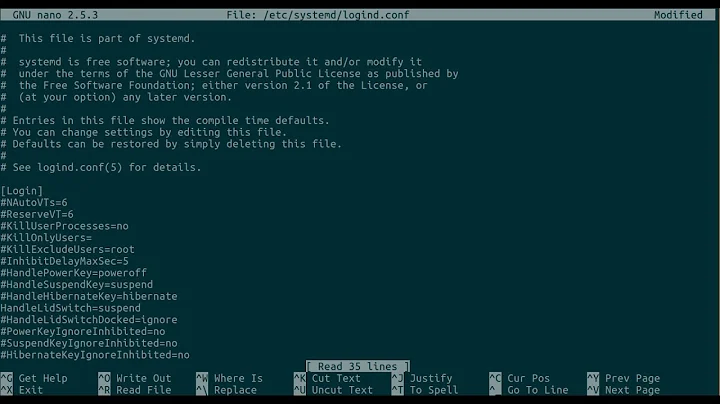suspend AND lock screen on closing lid in arch/systemd
Solution 1
There are a couple of examples in the Arch Wiki.
Basically, it involves creating a service file for your screen locker and ensuring it is hooked to either the suspend, hibernate or sleep targets.
If you use a simple screen locker like slock, /etc/systemd/system/lock.service would look like this:
[Unit]
Description=Lock the screen on resume from suspend
[Service]
User=jason
Environment=DISPLAY=:0
ExecStart=/usr/bin/slock
[Install]
WantedBy=suspend.targetOther examples on the wiki have more complex options, including shutting down and bringing up other services, etc.
Solution 2
If you use openrc with elogind is there an alternative solution (which is not systemd dependent):
#!/bin/sh
#
# /lib/elogind/system-sleep/lock.sh
# Lock before suspend integration with elogind
username=lerax
userhome=/home/$username
export XAUTHORITY="$userhome/.Xauthority"
export DISPLAY=":0.0"
case "${1}" in
pre)
su $username -c "/usr/bin/slock" &
sleep 1s;
;;
esac
ref: https://gist.github.com/ryukinix/bd0c1ddcbbafdb4149ae70e41b7c822b
I'm posting this because was very difficult to find it a proper way that it works and this thread appears on first results of google about "lock after suspend" or whatever.
Solution 3
All answers presented here have one fundamental flaw: They set the DISPLAY variable irespectively of what seat/session is active. And they involve writing your own systemd service file.
Thus, I suggest using the fact that logind (part of systemd, I believe) sends DBUS notifications before suspending. If you subscribe to these messages, you can start the screen locker from within you desktop environment and really lock the correct screen/session.
Additionally, there are programs like https://github.com/swaywm/swayidle that already implement this. For example, I've got this in my window manager's config:
exec swayidle -w \
timeout 300 'swaylock -i $wallpaper' \
timeout 600 'swaymsg "output * dpms off"' \
resume 'swaymsg "output * dpms on"' \
before-sleep 'swaylock -i $wallpaper' \
lock 'swaylock -i $wallpaper'
To automagically lock the screen after some time, before suspending and whenever screen locking is requested. I've set HandleLidSwitch=lock in /etc/systemd/logind.conf to have my laptop locked when I close it.
Edit: You will also need to enable DBUS support your desktop session. I launch my window manager (sway) directly from the console, so my call became
exec dbus-run-session sway
Similarly, you could probably (I did not properly test this part) start your X window manger, i3 in the example using the following line in you ~/.xinitrc
exec dbus-launch i3 > /dev/null
Edit: Please note, that this answer is given much later. I do not if this was already possible when these answers were given and do not wish to discredit any of the other authors.
Related videos on Youtube
pldimitrov
Updated on September 18, 2022Comments
-
pldimitrov almost 2 years
what is the most straightforward way to lock the screen AND suspend when closing the lid? I'm using event hooks in
/etc/systemd/logind.confand successfully suspend upon closing the lid. However I'm lost when it comes to the locking part - am I supposed to enable some screensaver service and how can I trigger two events at once inlogind.conf?-
 Admin over 5 yearsOutside of scope so I'm commenting: in i3 it's very easy to assign keybindings to commands. Since
Admin over 5 yearsOutside of scope so I'm commenting: in i3 it's very easy to assign keybindings to commands. Sincemod+Lwas already assigned toblurlockfor me, it was easy to havemod+Sbeblurlock && systemctl suspend -iinstead. So, not when closing the lid, but works very well to choose whether I just want to lock, or lock and suspend.
-
-
pldimitrov almost 11 yearsThanks, I saw that example but did not realize the
ExecStart=/usr/bin/slockbit refers to locking at first glimpse. -
CMCDragonkai over 8 yearsIf I suspend and come back, my X display manager has a screen lock, that's great. But what about my ttys? What if I'm logged in, and I suspended and I forgot to exit from my ttys, people could switch to there and continue their operations.
-
jasonwryan over 8 years@CMCDragonkai you want physlock then...
-
CMCDragonkai over 8 yearsThat looks great, how could one use physlock while disabling KDE's lock screen? I wouldn't want to have to unlock twice, through physlock then KDE's lock screen.
-
jasonwryan over 8 years@CMCDragonkai no idea: I avoid DEs for precisely that reason...
-
 Martin Ueding over 8 yearsThis does work, but only if you are the only user of the system. A cleaner solution is to use
Martin Ueding over 8 yearsThis does work, but only if you are the only user of the system. A cleaner solution is to usexss-lock(available in Debian, Arch Linux; also Fedora next week) and run that as a user together withi3lockorslock. -
jasonwryan over 8 years@MartinUeding Not so: I use this one a multi-user system and it works fine...
-
 Martin Ueding over 8 yearsBut only with one graphical session, right? Otherwise you would not have display 0.
Martin Ueding over 8 yearsBut only with one graphical session, right? Otherwise you would not have display 0. -
 Martin Ueding over 8 yearsOkay, I only have a problem with fixing DISPLAY. if one can get around that, is fine
Martin Ueding over 8 yearsOkay, I only have a problem with fixing DISPLAY. if one can get around that, is fine -
Benjamin Peter over 6 yearsFYI I am using i3lock and had to add
--nofork -
 Rolf about 6 years@MartinUeding and @jasonwryan,
Rolf about 6 years@MartinUeding and @jasonwryan,Useris hardcoded. The assumption that this machine will only be used byjason(or someone who knows his password, like his girlfriend, for example). Ideally, we'd wantUserto be whoever initiated the suspend, but I haven't found a solution for that (yet). -
 Rolf about 6 yearsBy the way,
Rolf about 6 yearsBy the way,xss-lockis nice but it looks for an X session, which I sometimes don't have. Maybe I can modify it and recompile it. -
Ben Ruijl over 5 yearsNote that this will fail if the laptop unexpectedly cannot suspend (you may not notice, since you closed the lid): geoff.greer.fm/2018/01/02/linux-laptop-locking
-
jarno about 3 yearsI wonder why you could not use systemd --user instance for the job and put the unit file e.g. in
~/.config/systemd/user/so not superuser privilege is needed? -
WhyNotHugo about 3 years
userunits cannot get triggered bysystemtargets directly -- so there's no straightforward way for user units to start when locking/sleeping. systemd-lock-handler works around this by translatingsystemevents touserevents.




